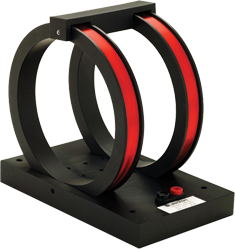More about the Model 480
Manual magnet testing
A bright display and fast update rate make the Model 480 ideal for manual magnet sorting and testing. The instrument’s low drift improves productivity with fewer adjustments. Remote terminals allow for foot pedal reading reset to keep hands on the work, not the instrument. Configurable alarms give an audible signal or relay closure to signify pass/fail.
Automated magnet testing
In automated testing, time is money. The Model 480 has many features to enhance throughput. The instrument has a fast update rate and fast settling time. It recovers quickly from reading reset to start a new reading cycle. The IEEE-488 and serial computer interfaces included with the 480 can be used to control most instrument functions. Relays and analog outputs can be used for automation without a computer interface.
Magnetizing
The magnetizing process places unique demands on all associated electronics. The Model 480 responds with a very fast peak capture that can keep up with the fastest magnetizing pulses. Both a positive and negative peak can be captured from the same pulse. The input of the Model 480 is protected against the high voltages present at its input during magnetizing.
Materials analysis
High resolution and low drift define a fluxmeter’s role in analytical measurement. The high resolution of the Model 480 is reinforced by a low noise floor. A configurable filter helps keep the readings quiet. Automatic and manual drift adjustment modes help optimize the integrators’ low drift characteristics. The IEEE-488 and serial computer interfaces included with the 480 allow automated data taking.
AC magnetic fields
Sensing coils are sensitive to AC magnetic fields but many conventional integrating fluxmeters can not measure AC fields. The Model 480 has an AC mode that enables it to measure fields over a wide frequency range using simple sensing coils. Applications are limited to field volumes as large or larger than the coil but for some, it is an inexpensive way to make low drift AC field measurements.
Drift adjustment
Adjusting or nulling the drift of an analog integrator wastes time. It can be the only unpleasant part of using an integrating fluxmeter. Lake Shore innovation brings some relief. The Model 480 has a built in drift algorithm that continually adjusts drift when the instrument and coil are idle. It is ready when you are to make precision low drift measurements. The adjustment algorithm has no effect during flux integration. Manual drift adjustment is also available.

* The Model 480 terminal block has connections for external reset. With this feature,a foot pedal or Programmable Logic Controller (PLC) can be used to start a new measurement cycle. The External Reset is TTL compatible and a logic low will activate a reset. The signal is internally pulled up to allow operation with a simple switch closure between pins 12 and 13.
Display
The Model 480 has a 2- line by 20-character vacuum fluorescent display. During normal operation, the display is used to report field readings and give results of other features such as max/min or relative. When setting instrument parameters, the display gives the operator meaningful prompts and feedback to simplify operation. The operator can also control display brightness.
Following are three examples of the various display configurations:

Normal reading—the default mode with the display of the live DC flux reading

DC positive and negative peak on—the display shows both the positive and negative DC peak readings

Alarm on—the alarm gives an audible and visual indication of when the flux value is selectively outside or inside a user specified range.
Helmholtz and search coils
Coils and probes wound by the user or from other manufacturers can be easily used with the Model 480. The Model 480 allows the user to save parameters for up to 10 existing coils/probes and quickly switch between them. Lake Shore also offers several sensing coils and probe assemblies for use with the Model 480, which offer several conveniences. They are calibrated at Lake Shore for accuracy and interchangeability. Calibration data is loaded into memory in the probe connector so it does not have to be entered by the user. Special coil assemblies are also available and can be designed to meet customer specifications.
FH-Series Helmholtz coils


